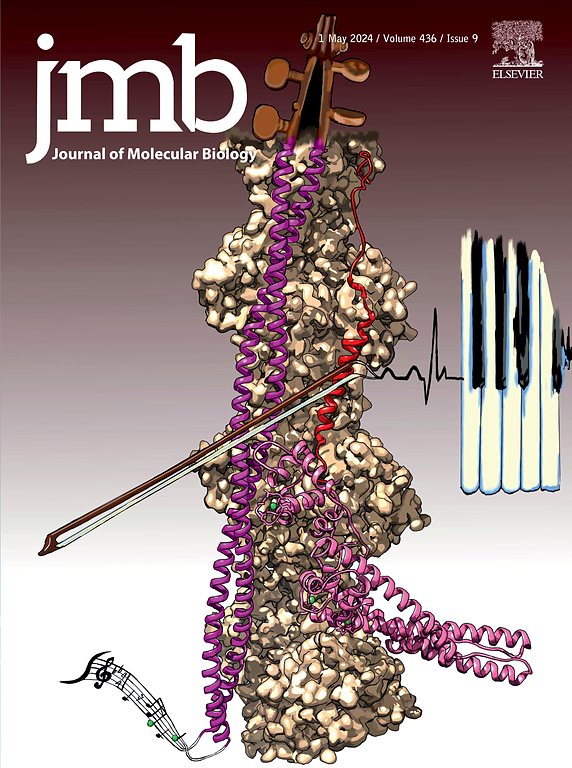载脂蛋白E同型结构域相互作用的HDX-MS研究。
IF 4.7
2区 生物学
Q1 BIOCHEMISTRY & MOLECULAR BIOLOGY
引用次数: 0
摘要
apoE4参与阿尔茨海默病(AD)的病理被认为是由于其独特的结构特性,最重要的是N端和c端结构域之间的相互作用。然而,对领域相互作用的结构理解仍然缺乏。在这里,我们使用氢-氘交换质谱(HDX-MS)通过测量c端结构域(CTD)对apoE3和apoE4中n端结构域(NTD)的溶剂可及性的影响来研究结构域相互作用。结果表明,CTD的存在提高了apoE4中NTD中所有四个螺旋的溶剂可及性,但只有两个螺旋,特别是apoE3中的Helix-1和4。因此,CTD诱导的NTD构象集合的变构变化在apoE4中比在apoE3中更为广泛。此外,强pH依赖性表明盐桥在结构域间相互作用中的作用。由于NTD包含受体结合区,CTD对其的不稳定作用为结构域间相互作用对apoE4病理功能的作用提供了结构基础。此外,我们提出HDX-MS作为一种筛选和评估针对apoE4的“结构校正”分子的有效性的方法,以减轻其在AD中的病理作用。本文章由计算机程序翻译,如有差异,请以英文原文为准。

Investigation of Domain Interaction in the Apolipoprotein E Isoforms by HDX-MS
Involvement of apoE4 in the pathology of Alzheimer’s disease (AD) is hypothesized to arise from its unique structural properties, most importantly the interactions between the N- and C-terminal domains. However, structural understanding of the domain interaction is still lacking. Here, we use Hydrogen-Deuterium Exchange Mass Spectrometry (HDX-MS) to study domain interactions by measuring the effect of the C-terminal domain (CTD) on the solvent accessibility of the N-terminal domain (NTD) in both apoE3 and apoE4. Our results indicate that the presence of CTD enhances the solvent accessibility of all the four helices in the NTD in apoE4, but only two helices, specifically Helix-1 and 4 in apoE3. Therefore, the allosteric changes in the conformational ensemble of the NTD induced by the CTD is more extensive in apoE4 than in apoE3. Moreover, strong pH dependence suggests role of the salt bridges in the interdomain interactions. Since the NTD harbors the receptor binding region, the destabilizing effect of CTD on it provides a structural basis for the role of interdomain interactions on the pathological functions of apoE4. Furthermore, we propose HDX-MS as a methodology for screening and assessing the efficacy of ‘structure corrector’ molecules targeting apoE4 to mitigate its pathological effects in AD.
求助全文
通过发布文献求助,成功后即可免费获取论文全文。
去求助
来源期刊

Journal of Molecular Biology
生物-生化与分子生物学
CiteScore
11.30
自引率
1.80%
发文量
412
审稿时长
28 days
期刊介绍:
Journal of Molecular Biology (JMB) provides high quality, comprehensive and broad coverage in all areas of molecular biology. The journal publishes original scientific research papers that provide mechanistic and functional insights and report a significant advance to the field. The journal encourages the submission of multidisciplinary studies that use complementary experimental and computational approaches to address challenging biological questions.
Research areas include but are not limited to: Biomolecular interactions, signaling networks, systems biology; Cell cycle, cell growth, cell differentiation; Cell death, autophagy; Cell signaling and regulation; Chemical biology; Computational biology, in combination with experimental studies; DNA replication, repair, and recombination; Development, regenerative biology, mechanistic and functional studies of stem cells; Epigenetics, chromatin structure and function; Gene expression; Membrane processes, cell surface proteins and cell-cell interactions; Methodological advances, both experimental and theoretical, including databases; Microbiology, virology, and interactions with the host or environment; Microbiota mechanistic and functional studies; Nuclear organization; Post-translational modifications, proteomics; Processing and function of biologically important macromolecules and complexes; Molecular basis of disease; RNA processing, structure and functions of non-coding RNAs, transcription; Sorting, spatiotemporal organization, trafficking; Structural biology; Synthetic biology; Translation, protein folding, chaperones, protein degradation and quality control.
 求助内容:
求助内容: 应助结果提醒方式:
应助结果提醒方式:


